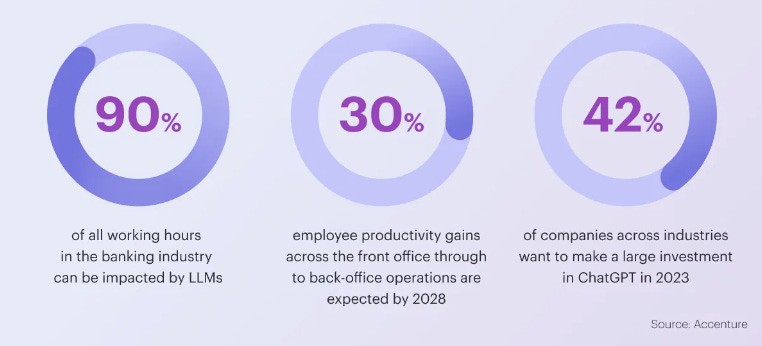Generative AI in Finance
Part-1/3: What is Generative AI and how will it affect Finance?
In the dynamic world of finance, where numbers dance and markets pulse with life, a new trio of revolutionary forces is emerging on the horizon – Generative AI, Explainable AI, and Responsible AI.
These aren’t just buzzwords; they are the facts of a new financial era, sculpting a landscape where innovation meets transparency, and ethics intertwine with technology. As we stand on the cusp of this transformation, let’s unravel the mysteries of these AI marvels, explore their boundless potential, and witness how they are redefining the very fabric of the financial industry.
This article is part of a three-part series, but I'm already going to give you an idea of what these topics mean and whether it is hype.
Generative AI in Finance
Explainable AI in Finance
Responisble AI in Finance
Let’s break the Knowledge Barrier
Generative AI (GenAI): GenAI is a type of AI that can generate new content, such as text, code, and images. It is still under development but can potentially revolutionize many industries, including finance. For example, GenAI could generate personalized financial advice, develop new financial products and services, and even automate complex financial tasks.
Explainable AI (XAI): XAI is a type of AI that can explain the reasons behind its decisions. This is important for finance, where transparency is critical. XAI can help financial institutions understand how their AI systems work, identify potential biases, and build customer trust.
Responsible AI (RAI): RAI is a set of principles and practices that guide the development and deployment of AI responsibly and ethically. This is important for all industries but especially for finance, where AI systems can significantly impact people's lives. RAI principles include fairness, transparency, accountability, and safety.
Is it Hype or Not?
The concepts of Generative AI (GenAI), Explainable AI (XAI), and Responsible AI (RAI) are not merely hype; they hold substantial promise and are integral to the ethical and effective implementation of AI across various industries, including finance.
Generative AI (GenAI):
Not Hype: GenAI has demonstrated its potential through applications like content creation, data augmentation, and personalized services. It is actively being researched and developed to address real-world challenges and create value.
Attention Point - Consistency: However, not everything about GenAI is green. It requires much attention, optimizing, and hardware resources to make it run.
Explainable AI (XAI):
Not Hype: The demand for transparency and accountability in AI-driven decisions, especially in regulated industries like finance, makes XAI essential. It is key in building trust, ensuring compliance, and mitigating biases.
Attention Point – Balancing Act: Striking the right balance between model accuracy and explainability is a significant challenge. Highly accurate models can be complex and harder to interpret, while simpler, more explainable models may compromise performance. Navigating this trade-off is essential for the successful implementation of XAI.
Responsible AI (RAI):
Not Hype: With the increasing integration of AI in daily life, adhering to ethical standards and ensuring the responsible use of AI is paramount. RAI principles are being adopted by organizations to safeguard individual rights and societal values.
Attention Point – Implementation Consistency: Ensuring consistent adherence to RAI principles across diverse applications and industries is challenging. Developing standardized guidelines and frameworks for responsible AI practices is vital to prevent discrepancies and uphold ethical standards.
I. Generative AI (GenAI)
Source: Accenture
One of the most important messages: GenAI is still under development but can potentially revolutionize many industries, including finance.
It has the potential to revolutionize the financial industry in several ways; here are 4 main domains:
Source: 17 ChatGPT Use Cases for Banks and Finance (tovie.ai)
Employee personal effectiveness: From Coding to email writing, there are 100 use cases to increase the effectiveness of your employees.
Specific banking and fintech tasks: Writing offers to clients, searching files, etc…
Efficient customer support: GenAI Driven Chatbot for your products, …
Creating new value for customers: GenAI Driven Chatbot to support in case of issues, …
There are two groups of GenAI deployed models: On-premise vs. On-Cloud.
→On-cloud systems are typically more scalable and easier to deploy than on-premise GenAI systems.
→However, on-prem GenAI systems offer greater control and security over the data used to train and deploy the GenAI system.
On-Cloud vs. On-Premise GenAI in Finance
Whether to deploy GenAI on-cloud or on-premise depends on several factors, including the specific needs of the financial institution, the type of GenAI system being deployed, and the regulatory environment in which the financial institution operates.
On-Cloud GenAI
On-cloud GenAI systems offer several advantages, including:
Scalability: On-cloud GenAI systems can be scaled quickly and easily, depending on the financial institution's needs.
Ease of deployment: On-cloud GenAI systems are typically easier to deploy and manage than on-premise GenAI systems.
Cost: On-cloud GenAI systems can be more cost-effective than on-premise GenAI systems, especially for financial institutions with variable workloads.
However, on-cloud GenAI systems also pose some challenges, including:
Security: Financial institutions must ensure their data is secure when stored and processed in the cloud.
Compliance: Financial institutions must ensure that their use of on-cloud GenAI systems complies with all applicable laws and regulations.
On-Prem GenAI
On-premise GenAI systems offer several advantages, including:
Security: Financial institutions have greater control over their data security when they deploy GenAI systems on-premise.
Compliance: Financial institutions have greater control over how their GenAI systems are used when they deploy them on-premise.
However, on-premise GenAI systems also pose some challenges, including:
Scalability: On-premise GenAI systems can be difficult to scale up or down quickly and easily.
Cost: On-premise GenAI systems can be more expensive than on-cloud GenAI systems, especially for financial institutions with variable workloads.
Complexity: On-premise GenAI systems can be more complex to deploy and manage than on-cloud GenAI systems.
Whether to deploy GenAI on-cloud or on-premise is a complex one that should be made on a case-by-case basis. Financial institutions should carefully consider their specific needs and requirements before deciding.
There's no one-size-fits-all solution; deploy on-premise and in the cloud according to your use cases.
The grain in the eye through the use of GenAI
Addressing the challenges of Generative AI in finance is pivotal for harnessing its full potential. One of the significant hurdles is the allocation of internal resources for deployment. Financial institutions must meticulously assess and allocate the necessary human and technological resources to ensure the seamless integration and functioning of Generative AI systems. This involves technical expertise and a comprehensive understanding of the financial landscape.
Yet, we are talking about human and technical resources when GenAI models are used in the field. These models are not little 100-parameter models; they have billions of parameters! Keep that in mind when you deploy them in the field.
Measuring the accuracy of Generative AI is also a critical concern. Financial institutions must establish robust metrics and evaluation methods to assess the performance and reliability of AI-generated content and solutions. Ensuring the accuracy of Generative AI is paramount, as inaccuracies can lead to misguided financial decisions and erode trust in AI-driven solutions, especially when customers directly interact with GenAI solutions - this is where safeguards are essential!
Furthermore, deploying Generative AI on legacy and modern platforms presents challenges. Financial institutions must navigate the complexities of integrating advanced AI technologies with existing systems, ensuring compatibility, and addressing potential conflicts. Striking a balance between innovation and continuity is essential for maintaining operational efficiency while embracing the transformative capabilities of Generative AI.
II. Conclusion
In conclusion, as we delve deeper into the intricacies of Generative AI and its impact on the financial industry, it becomes evident that the journey is as challenging as it is promising. The road ahead is paved with opportunities for innovation, but it also demands vigilance and adaptability.
Stay tuned as we continue this exploration and turn our focus to Explainable AI in the next part of this series, shedding light on its significance, potential, and the challenges it brings to the ever-evolving world of finance.




